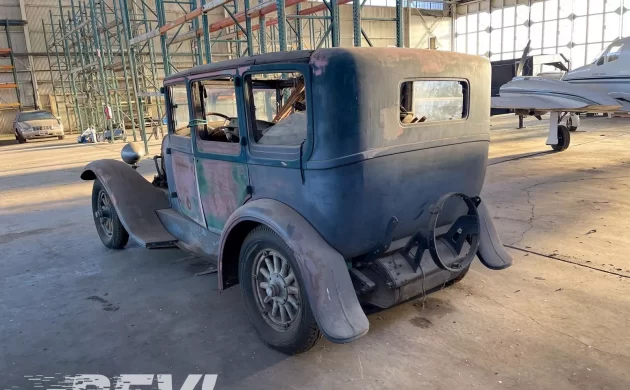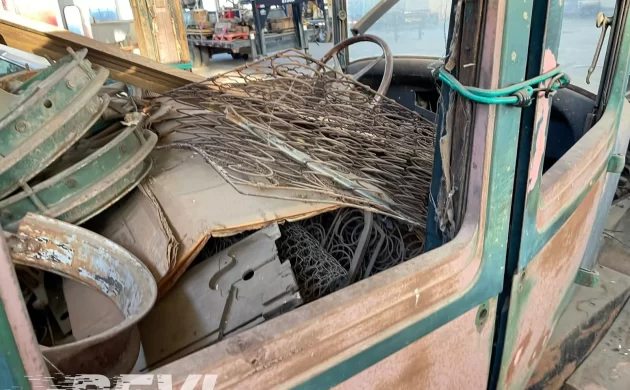Part of the fun of studying automotive history is finding an instance of a company implementing a different idea. While everyone else was using liquid cooling, Franklin Automobile Company stubbornly clung to the idea that air cooling was the way to go. Despite proving the concept, the company became one of the many that went under during the Depression. Almost 100 years later, very few surviving examples of this company’s innovative work are left to examine. Are you looking for a project car vastly different than the usual prewar automobile? This 1929 Franklin Model 130 sedan for sale on eBay in Stockton, California may meet your approval. With its air-cooled engine and aluminum body, Franklins were decidedly different. Do those differences make this car worth the $10,000 buy-it-now price, or would you rather take a chance on bidding, which is currently languishing at $1,000 with exactly zero bids? Can the desire for something different sustain you through what will be an arduous restoration project?
The Franklin Automobile Company produced its first car in 1902 and managed to stay in the automobile business until 1934. While there were hundreds of automakers at one time or another before World War II, Franklin stubbornly stood apart from its competitors. Their philosophy concerning automobiles was that an air-cooled automobile would be simpler, have fewer parts, and thus, less weight. They further reduced the weight of their cars by using aluminum in the bodies of many of their cars. While the Syracuse, New York automaker had its loyal followers, poor decision-making going into the Great Depression set the company up for failure. According to Franklin historian Sinclair Powell, the company stubbornly clung to such practices as building cars using craftspersons instead of implementing mass production strategies, using aluminum when steel would have been cheaper, not outsourcing when necessary, and clinging to a poorly distributed dealer network. The final nail in the coffin was the development and production of a twelve-cylinder engine, air-cooled of course, during the depths of the Depression. When automobile production ended in 1934, the Franklin name and all of the company’s assets were sold. Interestingly, the air-cooled engines the company was famous for continued to be produced under the banner of Aircooled Motors of Syracuse in one form or another until 1975.
When you look at the logic behind leaving the radiator, water pump, and all of the casting headaches that come with the necessity of water passages behind, one has to wonder why air cooling never gained a foothold in the market until the Volkswagen Beetle came around after the war (with the Corvair close behind). Henry Ford experimented with air cooling, as did Charles Kettering with the infamous copper-cooled Chevrolets. Even Chrysler worked on prototype air-cooled engines in their “Star” cars, which developmentally became the Airflow. Franklin made the concept work well, but perhaps they were bound by the restraints of being a luxury car manufacturer. A lower-cost automobile manufactured efficiently may have worked, but there is no indication that the company ever explored this option. There was also the issue of metallurgy. Air-cooled engines rely heavily on aluminum and copper to efficiently radiate heat. Aluminum production was in its infancy at the time and was notorious for the impurities that were found in the finished product. Copper was, and always has been a relatively expensive metal compared to the cast iron used in most engines of the time, and its heat transfer abilities could be hampered by inevitable corrosion.
The 1929 Franklin Model 130 sedan you see here is a fascinating study of just how far along Franklin was with air cooling. Equivalent to the Packards and Cadillacs of its era, this car is now in sad shape with diminished chances of being restored. Conspicuously absent is the hood and grille assembly that made the car resemble its water-cooled competition instead of the Renault-like hoods worn by older Franklins. The removed parts sit forlornly inside the body of the car. In the ad, we are told that “Most all the components required to restore this beast to its former beauty packed inside the passenger compartment.” That is not a reassuring statement given the complete lack of available Franklin parts on the market today. The only good news is that 3D printing is making great leaps in providing hope to the owners of orphan automobiles when it comes to simple parts. If that doesn’t work, then machine shops are everywhere.
The seller tells us they can trace the ownership of the car back to 1980. All of the owners they are aware of were from California, and the car does appear to have been from a dry climate. Of course, there is no rust to deal with considering that the body is made of aluminum. That extensive use of aluminum was one of the reasons that Franklins of this era weighed around 2,800 lbs. The engine is believed to be a 274 cubic inch inline six-cylinder backed up by a three-speed manual transmission. There is no mention in the ad of the engine’s condition internally or if it rotates.
Franklin produced 14,289 automobiles in the fateful year of 1929. It makes you wonder just how many survivors there are out there. Owning such a car would be interesting, and you would have to become an amateur history teacher duty bound to inform everyone who came up to you to ask about it at shows. Too bad so few people know about Franklins. It seems that air cooling was an idea that should have flourished. Ironically, it took a few decades for a former enemy to show us just how practical and economical such engines could be. Hopefully, a brave soul steps forward and restores this Franklin to help keep the name and story alive.
Have you ever heard of a Franklin? Why do you think the idea of air cooling never caught on domestically? Would you be brave enough to undertake this restoration? Please share your thoughts in the comments.










Actually, on paper, an air cooled motors would be a lot simpler, and it is as the author mentioned, but like all air cooled motors, the fan has to spin, and as roads and cities got more crowded, slow going was the kiss of death. I heard many fan cooled in line motors, the back cylinders got hot, and liquid cooling solved all that. Flat air cooled do a bit better too. Fan cooled diesels seem to be popular,, but again, in farm equipment, the fan is always spinning full tilt. I always wondered, if these cars made a distinctive noise of the fan whooshing, sucking in small birds and such. Again, limited interest spells doom for these once great cars. I heard Franklins really rolled on the open road. Anyone that drove these cars is long gone, so I guess we’ll never know.
Water cooling also enabled engine tolerances to be tightened up, making the engines more powerful and efficient. It’s the main reason air-cooled automotive engines are gone today.
This car just screams to be a Leno project! A very informative write up.
It is odd that the cooling seems to occur from the front to back, rather than side to side, which would seem to provide more even flow. Perhaps shrouds direct it?
I’d be surprised if it gets a Grand, but who knows. Its rare, but that that doesn’t equal desirable. Now if it were a steam Doble, things would be different!
Franklin made aircraft engines long after they stopped making cars. They were highly regarded as helicopter engines and soup-ups for Cessnas
Parts car for a Franklin Club member.
Porsche visited the Franklin factory, researching manufacturing and engineering…
Days gone by not worth throwing 80k at sorry
pop cans
Franklin was a car whose time had come and gone yet hardly anyone noticed. Later, VW and the Corvair put air-cooled engines on the map but those too are gone, thanks to changing times and requirements. Also, someone correct me if I’m wrong but I believe the Tucker used a radial flat-mounted air-cooled helicopter engine.
Not a radial, but a flat 6 Franklin O-335 aircraft engine converted from air-cooled to liquid-cooled.
This would be iffy were it a Pierce Arrow. Body would likely have to be disassembled and a new wooden structural cage made from the chassis up. I’m assuming that Franklin did away with hickory chassis by ’29. There is aways someone crazy enough to take something like this on. I claim the crown dunce award having once done a ’29 Pontiac 4 door between ages of 14 and 34. There’s one born every minute.
Interesting about air-cooled engines – my 2013 BMW R1200R is air cooled and does just fine. Admittedly, hanging the boxer cylinders into the wind is a great way to keep them cool, but I have owned many other bikes with parallel cylinder air-cooled engines that have been fine on hot days and in traffic. Mostly air cooling has been eliminated to control NOx and SOx emissions, which is hard to do when you have no control over the combustion chamber temperature.
The radiators filled with engine oil help.
Ad says the car is in Stockton, but the dealer is in Illinois. How does that work??
An acquaintance of mine has over 20 Franklins. In 2019 we did a benefit car show for the Hayden Cabin Museum in Mammoth Lakes, CA. and he brought one up for the show, handed me the keys and said, “enjoy it and I’ll see you in a couple weeks”. It was a fantastic car with amazing fit and finish.
Sad that the body is all there as it would be a perfect candidate for a speedster rebody were it not. Can you imagine something like a Kissel Gold bug body? As I said this would be iffy were it a Pierce Arrow or Cord L 29s. Only a Duesenberg, Bugatti or Delage/Delahaye would warrant what this baby needs. And I am the Jack Ass that redid a ’29 Pontiac roughly like this only I didn’t know what I was getting into, and only my obsessive/compulsive disorder prevented from bailing when I should have
https://franklinmuseum.org/
I wonder if the Franklin Museum in Tucson, Arizona has one of these or could assist with someone who purchases it for restoration?
I had a 1925 Franklin Series 11-A. Aluminum body, second-growth white Ash frame (sagging and delaminating – made using 3 laminations of ~3/4″ Ash). Second growth Ash was because it was typically straighter and had good uniformity of the grain structure.
This car and the other Franklin models in the 1920 had flow from the top down past the cylinders. They cylinders were single piece (no head) with cast-in copper fins.
In the early thirties before going under they had the Aero series which and produced air-cooled V-12’s with cross-flow cooling of the cylinders.
Fond memories but I wouldn’t buy a project at this point in my life.
I seem to recall that air-cooling also made it difficult to maintain pollution controls, whereas liquid-cooling could keep the engine in a tighter operating temperature range.